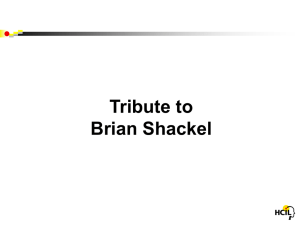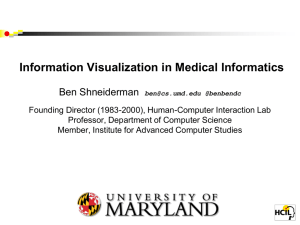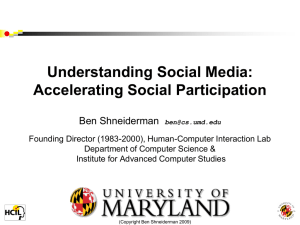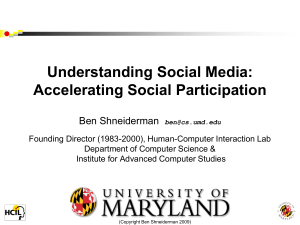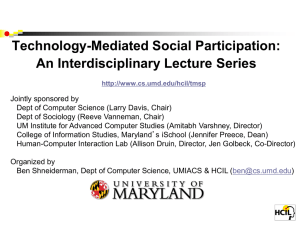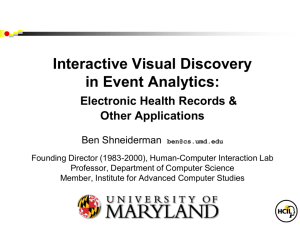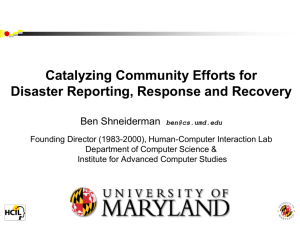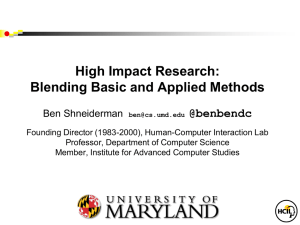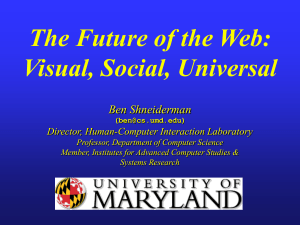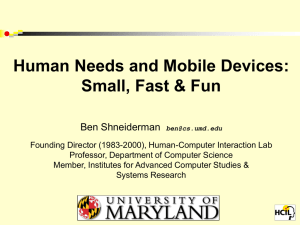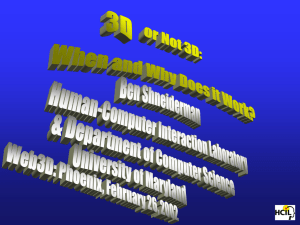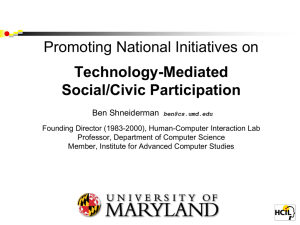Slides - Dartmouth College
advertisement
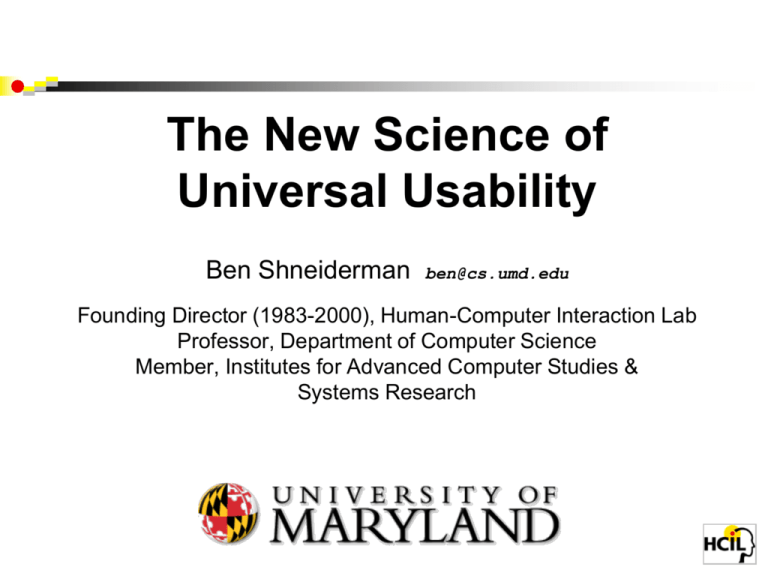
The New Science of Universal Usability Ben Shneiderman ben@cs.umd.edu Founding Director (1983-2000), Human-Computer Interaction Lab Professor, Department of Computer Science Member, Institutes for Advanced Computer Studies & Systems Research University of Maryland College Park, MD 20742 Interdisciplinary research community - Computer Science & Info Studies - Psych, Socio, Poli Sci & MITH (www.cs.umd.edu/hcil) Scientific Approach (beyond user friendly) • • • • • Specify users and tasks Predict and measure • time to learn • speed of performance • rate of human errors • human retention over time Assess subjective satisfaction (Questionnaire for User Interface Satisfaction) Accommodate individual differences Consider social, organizational & cultural context Design Issues • • • • Input devices & strategies • Keyboards, pointing devices, voice • Direct manipulation • Menus, forms, commands Output devices & formats • Screens, windows, color, sound • Text, tables, graphics • Instructions, messages, help Collaboration & communities Manuals, tutorials, training U.S. Library of Congress • Scholars, Journalists, Citizens • Teachers, Students Visible Human Explorer (NLM) • Doctors • Surgeons • Researchers • Students NASA Environmental Data • Scientists • Farmers • Land planners • Students NSF Digital Government Initiative • Find what you need • Understand what you Find Census, NCHS, BLS, EIA, NASS, SSA www.ils.unc.edu/govstat/ iSonic: Sonification for Maps • • Motivation: improve vision-impaired users’ access to geo-referenced statistical data Approach: interactive sonification • Data-to-sound mapping: Piano pitch -> value. • User study: 7 blind subjects, 6 hours each • Users can recognize geographical patterns • Users preferred spatial audio map over table www.cs.umd.edu/hcil/audiomap International Children’s Digital Library www.childrenslibrary.org Home Medical Devices • Bathroom scale • Thermometer • Blood pressure • Diabetes: Glucose • Asthma: Breath • Fat monitor • EKG www.cs.umd.edu/hcil/soh/ws_meddevice.htm Electronic Health Records: LifeLines www.cs.umd.edu/hcil/lifelines/ Spotfire: DC natality data Treemap: Stock market, industry clustered www.smartmoney.com/marketmap Treemap: Product catalogs www.hivegroup.com Treemap: Newsmap Creativity Support Tools More people, More creative, More often 6th Creativity & Cognition Conference • Washington, DC June 13-15, 2007 • Receptions at Nat’l Academy of Sciences & Corcoran Gallery of Art • Expand community of researchers • Bridge to software developers • Encourage art & science thinking http://www.cs.umd.edu/hcil/CC2007/ www.cs.umd.edu/hcil/CC2007 Leonardo’s Laptop The old computing is about what computers can do, The New Computing is about what people can do mitpress.mit.edu/leonardoslaptop www.cs.umd.edu/hcil/newcomputing Requirements Analysis In a fair society, all individuals would have equal opportunity to participate in, or benefit from, the use of computer resources regardless of race, sex, religion, age, disability, national origin or other such similar factors. -- ACM Code of Ethics Goals of Public Access • Enable participation by every citizen & visitor Voting Licenses Passports Registrations Permits Regulations • Social security services Police-fire-emergency National-local government Offer services to all Healthcare Housing Education Employment, Shopping Museums Libraries Transportation Recreation Sports Tourism Entertainment Universal Usability Challenges • • • Technology variety • Fast & slow modems, small & large displays • Diverse platforms, multiple versions User diversity • Novice & expert, old & young • Users with disabilities, poor literacy, or low motivation Bridge the gap between what users know and what they need to know • Multi-layer interfaces • Help vs. ShowMe! Communications of the ACM, May 2000 Technology variety 1 to 100 range in processor speeds 486 Pentium Multi-core 1 to 100 range in screen sizes Palm devices 80,000 Laptops 800,000 Device Independence Input: keyboard, speech,... Output: visual, auditory,... Conversion Large Desktop or Wall Display 8,000,000 pixels 1 to 100 range in network bandwidth 9.6K 56K 10,000Kbps Software Versions Compatibility File conversion Multiple platforms User diversity: Accommodate all users Skills Computer newbie to hacker Knowledge Disabilities Visual, auditory, motoric, cognitive Domain novice to expert Age Young to old Gender Male or Female Disabling conditions Mobility, injury, noise, sunlight Income Impoverished to wealthy User diversity: Accommodate all users Race Ethnicity Religion National Origin Culture Western, Eastern, developing... Personality Introvert vs extravert Thinking vs feeling Risk aversion Locus of control Planful vs playful Literacy Fluent to illiterate Multiple languages Gaps in User Knowledge-Strategies Bridge the gap between what users know and what they need to know Online Learning Design Multi-Layered Task-oriented (evolutionary, phased) Introductory tutorials Getting started manuals, Cue cards Walkthroughs/Demos Minimalist/Active Training Fade-able scaffolding Training wheels Minimalist Online help Context sensitive, tables of contents, Indexes, Keyword search, FAQs, answer gardens Gaps in User Knowledge-Strategies Bridge the gap between what users know and what they need to know Customer service Email Phone Help desks Supplements Online manuals, paper Audio, video, Live lecture, peer training, personal trainer Community Newsgroups, online communities Chat rooms Research Agenda for Universal Usability For Desktop, Web, and Mobile Devices: • • • • • Evidence-based Guidelines Automated analysis tools Improved application generators Improved user customization tools Social facilitation • Tested with developers & users Shneiderman & Hocheiser, Behaviour & Info Technology, 2001 HCI Challenges • • • • • • Information Access Universal Usability Trusted Voting Healthcare Information Visualization Creativity Support Tools HCI Challenges • • • • • • • • • Information Access Universal Usability Trusted Voting Healthcare Information Visualization Creativity Support Tools Environmental Sustainability Emergency/Disaster Response International Development UN Millennium Development Goals To be achieved by 2015 • Eradicate extreme poverty and hunger • Achieve universal primary education • Promote gender equality and empower women • Reduce child mortality • Improve maternal health • Combat HIV/AIDS, malaria and other diseases • Ensure environmental sustainability • Develop a global partnership for development Interdisciplinary Challenges • Modern problems are complex • Solutions require multiple disciplines • Laboratory studies have limited relevance • Natural sciences are not sufficient Historic Transformation • Existing sciences have reached limits: • • • The End of Science: Facing the Limits of Knowledge in the Twilight of the Scientific Age, John Horgan End of Physics End of Computer Science End of History, Francis Fukuyama Science 1.0 • Reductionist • Controlled • • • Experiments Replicability Laboratory Natural World Science 1.0 • Reductionist • Controlled • • • Experiments Replicability Laboratory Natural World + Science 2.0 Integrated Case Studies Validity Situated Made World Science 1.0 • Reductionist • Controlled + Science 2.0 Integrated Case Studies Validity Situated Made World • • • Experiments Replicability Laboratory Natural World • • • Hypothesis Testing Hypothesis Testing Predictive Theories Predictive Theories Replications Replications Science 2.0 Emerges Interdisciplinary study of the made world Socially embedded Bringing closer together - theory & practice - basic & applied research New research directions (Emerson, Dewey, James, Vygotsky, Simon, Suchman, Berners-Lee,… … and many of you!) Science 2.0 Evaluation Methods Ethnographic Observational Situated • Multi-Dimensional • In-depth • Long-term • Case studies Science 2.0 Evaluation Methods Ethnographic Observational Situated • Multi-Dimensional • In-depth • Long-term • Case studies Domain Experts & Communities Doing Their Own Work for Weeks & Months Science 2.0 Evaluation Methods Ethnographic Observational Situated • Multi-Dimensional • In-depth • Long-term • Case studies MILCs Shneiderman & Plaisant, BeLIV workshop, 2006 MILC example • • • • • Evaluate Hierarchical Clustering Explorer Focused on rank-by-feature framework 3 case studies, 4-8 weeks (molecular biologist, statistician, meteorologist) 57 email surveys Identified problems early, gave strong positive feedback about benefits of rank-by-feature Seo & Shneiderman, IEEE TVCG 12,3, 2006 MILC example • • • • Evaluate SocialAction Focused on integrating statistics & visualization 4 case studies, 4-8 weeks (journalist, bibliometrician, terrorist analyst, organizational analyst) Identified desired features, gave strong positive feedback about benefits of integration Perer & Shneiderman, 2007 Case Study Methodology 1) Interview (1 hr) 2) Training (2 hr) 3) Early Use (2-4 weeks) 4) Mature Use (2-4 weeks) 5) Outcome (1 hr) Short Range Goals • Validate benefits of new designs • Collect evidence to support/reject hypothesis - rank-by-feature - integrating statistics & visualization • Rapid refinements of tools • Benefits to users Long Range Goals • Harness Collaboration • • • • Pair-wise Small Team Larger Group Social Creativity Long Range Goals • Harness Collaboration • • • • Pair-wise Small Team Larger Group Social Creativity Thomas Edison: 1% Inspiration, 99% Perspiration Long Range Goals • Harness Collaboration • • • • Pair-wise Small Team Larger Group Social Creativity Thomas Edison 2.0: 1% Inspiration, 99% Collaboration Long Range Goals • Understand dynamics of • • • • • Trust Empathy Responsibility Privacy Etc. Thomas Jefferson I feel... an ardent desire to see knowledge so disseminated through the mass of mankind that it may...reach even the extremes of society: beggars and kings. -- Reply to American Philosophical Society, 1808 25th Annual Symposium May 29, 30, 2008 www.cs.umd.edu/hcil
